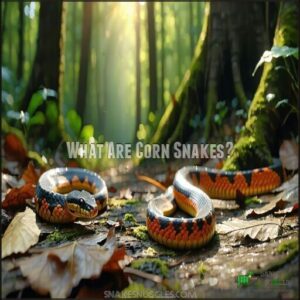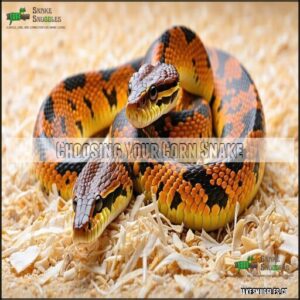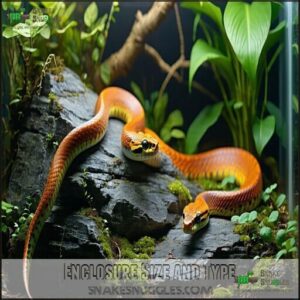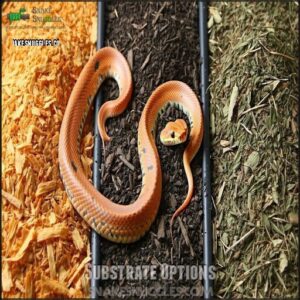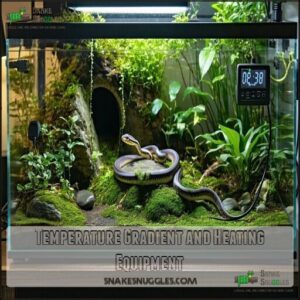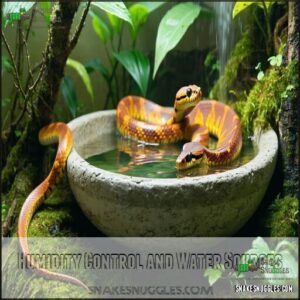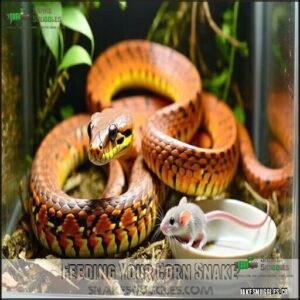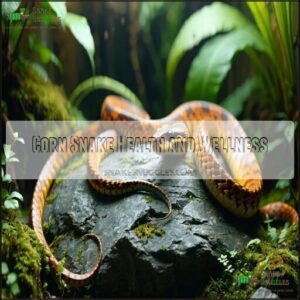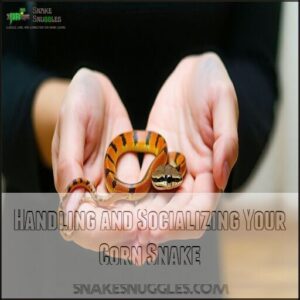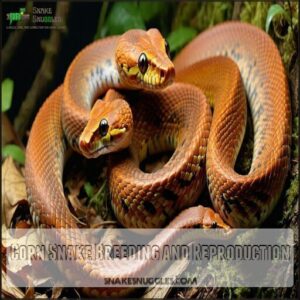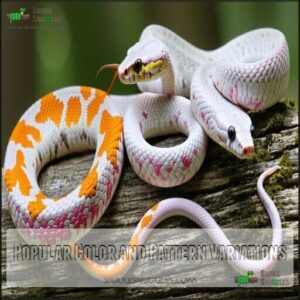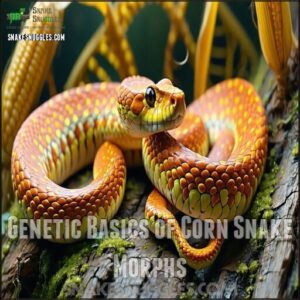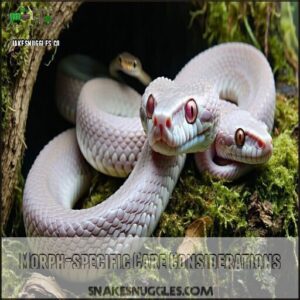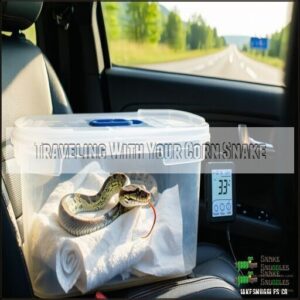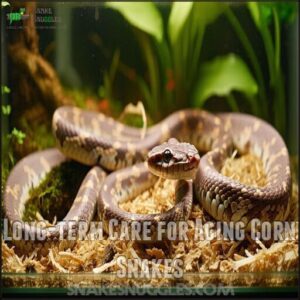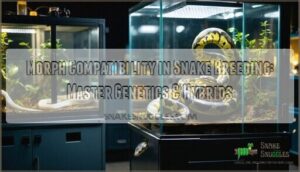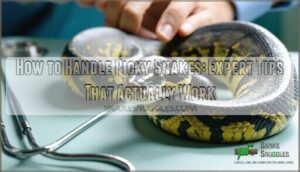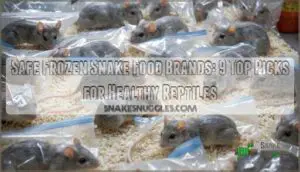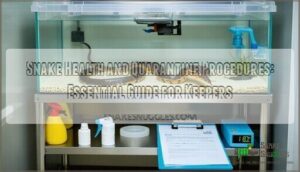This site is supported by our readers. We may earn a commission, at no cost to you, if you purchase through links.
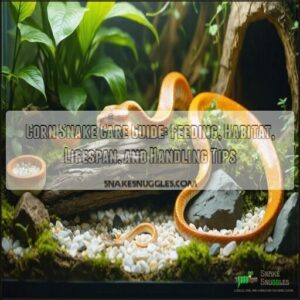 You’ll need a 20-gallon tank for your corn snake with proper heating (85°F warm side, 75°F cool side).
You’ll need a 20-gallon tank for your corn snake with proper heating (85°F warm side, 75°F cool side).
Use aspen bedding and provide two hiding spots. Feed pre-killed mice every 5-7 days for juveniles, every 7-10 days for adults.
Your corn snake needs fresh water daily. Handle your snake gently for short periods, supporting its body fully.
Clean the enclosure monthly and watch for signs of respiratory infections or mites. Corn snakes live 15-20 years with proper care, making them long-term companions. The right setup means the difference between a stressed snake and one that thrives for decades.
Table Of Contents
- Key Takeaways
- What Are Corn Snakes?
- Choosing Your Corn Snake
- Setting Up The Perfect Corn Snake Habitat
- Feeding Your Corn Snake
- Corn Snake Health and Wellness
- Handling and Socializing Your Corn Snake
- Corn Snake Breeding and Reproduction
- Corn Snake Morphs and Genetics
- Traveling With Your Corn Snake
- Long-term Care for Aging Corn Snakes
- Frequently Asked Questions (FAQs)
- How do you care for a corn snake?
- How does poor care affect corn snakes?
- Do corn snakes need a hide?
- Do corn snakes need light?
- Are corn snakes hard to care for?
- What do corn snakes need in their tank?
- Do corn snakes need a heat lamp?
- What is the lifespan of a corn snake?
- What not to do with a corn snake?
- How often should you mist a corn snake?
- Conclusion
Key Takeaways
- You’ll need a 20-gallon tank with proper temperature gradient (85°F warm side, 75°F cool side) and at least two hiding spots to keep your corn snake healthy and reduce stress.
- Feed your corn snake pre-killed mice every 5-7 days for juveniles or every 7-10 days for adults, and provide fresh water daily to maintain proper hydration.
- Handle your snake gently and regularly to build trust, always supporting its full body length and washing your hands before and after handling.
- Monitor for health issues like respiratory infections or mites, clean the enclosure monthly, and expect a 15-20 year commitment with proper care.
What Are Corn Snakes?
Corn snakes are non-venomous, slender-bodied snakes native to the southeastern and central United States, often found in forests, fields, and overgrown areas.
Corn snakes are non-venomous, slender-bodied snakes native to the southeastern and central United States, often found in forests, fields, and overgrown areas.
They grow to 3-6 feet in length, display vibrant patterns, and are known for their calm temperament.
Origin and Natural Habitat
Corn snakes (Pantherophis guttatus) are native to North America, thriving from New Jersey to Texas.
They adapt well to diverse habitats like pine forests, rocky hillsides, and meadows. You might spot them hiding under logs, within underbrush, or even in abandoned barns.
Their geographic variations guarantee they blend into their surroundings, while their wild diet—mainly rodents—helps control pests.
These snakes are versatile survivors, active at dawn and dusk, adjusting their activity patterns to their environment.
Notably, they’re named “corn snakes” because farmers often found them in grain cribs, feasting on rodents amidst stored crops. Truly, they’re nature’s pest controllers.
They’re also found in the southeastern United States, as far west as Mexico.
Physical Characteristics and Appearance
With smooth scales and striking colors, a corn snake’s beauty is undeniable.
Their sleek body size ranges from 3-5 feet, with soft curves shaping their oval heads.
Signature snake patterns include vibrant orange hues with black-edged blotches, while bellies show maize-like checkerboards.
Sensory organs, like round pupils, add to their approachable charm.
The realm of color morphs, boasting over 800 options, offers endless color variations.
- Distinctive head shape: Oval and soft.
- Snake size: Perfectly manageable at 3-5 feet.
- Scale patterns: Smooth and uniform.
- Sensory organs: Harmless round pupils.
- Color morphs: Endless uniqueness!
Lifespan and Growth Rate
Corn snakes hatch at 8-12 inches long, growing quickly with proper care.
Adults generally reach 3.5–5 feet, with rare individuals exceeding 6 feet.
They live 10–15 years on average but can surpass 25 years with excellent care.
Growth depends on diet, environment, and overall health.
Shedding frequency varies by age, with younger snakes shedding more often.
| Stage | Length | Key Changes |
|---|---|---|
| Hatchling | 8–12 inches | Rapid growth, frequent sheds |
| Juvenile | 1.5–3 feet | Slower growth begins |
| Sub-adult | 3–4 feet | Maturing, less shedding |
| Adult | 3.5–5 feet | Stable size, fewer sheds |
| Senior | 3–5.5 feet | Growth stops, health declines |
Temperament and Behavior
A calm, docile nature is one of the corn snake’s most appealing traits.
They’re beginner-friendly, with gentle temperaments and minimal defensive behaviors. You’ll notice their movements are slow and relaxed—clear signs of comfort. While they rarely get aggressive, they might react when stressed, like rattling their tails or hissing.
Understanding snake behavior makes handling easier. Keep an eye on their activity patterns, as they’re crepuscular and mostly active at dawn and dusk.
- Relaxed movements: Your snake feels safe.
- Tail rattling or hissing: Signs of stress; give space.
- Individual variation: Some snakes are naturally more active or shy.
Learning their temperament guarantees a better connection.
Choosing Your Corn Snake
When choosing a corn snake, focus on finding a healthy, active specimen with clear eyes and smooth skin.
Consider different morphs and beginner-friendly traits to match your preferences and experience level, focusing on finding a healthy specimen.
Morph Varieties Available
Exploring corn snake morphs reveals endless beauty shaped by color and pattern mutations.
From the vibrant Amelanistic to the striking Anerythristic, morph identification keeps enthusiasts engaged.
Rare morphs like Candy Cane stand out, while designer morphs blend genetics into future trends.
These unique variations showcase pattern inheritance, offering eye-catching visuals that make each corn snake truly one-of-a-kind.
Selecting Healthy Specimens
When picking a corn snake, focus on its appearance and behavior for signs of good health. Choose a reptile with clear eyes, shiny scales, and a smooth, unmarked body.
The vent should be clean, with no swelling or discharge. Watch for an active activity level—a sluggish snake might signal illness.
Stick to breeders with excellent Breeder Reputation who care about snake health. A well-fed snake will have a healthy, proportional body weight, not too thin or unusually plump.
Inspect thoroughly and ask questions. It’s always better to pick a lively, alert snake that seems ready to explore its surroundings!
-
What to Check:
- Eyes: Clear, no cloudiness.
- Scales: Shiny and smooth.
- Movement: Active, engaging.
- Body: Proportional weight.
Beginner-Friendly Snake Breeds
When picking a beginner pet snake, a corn snake is a top choice.
These docile reptiles are easy to maintain, tolerate handling well, and don’t need complex care.
Ball pythons are also fantastic—quiet and calm even when nervous.
For something lively, try king or milk snakes; both are energetic yet beginner-friendly.
Consider garter snakes too, though they might release a smelly musk when scared.
Focus on ease of care, enclosure needs, and size considerations before deciding.
Researching proper care and understanding temperament concerns are key to guaranteeing a happy, healthy start with your pet reptile.
Setting Up The Perfect Corn Snake Habitat
Creating a proper habitat for your corn snake guarantees its health and comfort.
You’ll need to balance the right enclosure size, substrate, temperature, and humidity to replicate its natural environment.
Enclosure Size and Type
A proper corn snake habitat starts with choosing the right enclosure setup.
Hatchlings need at least a 10-gallon terrarium, while adults thrive in 20-40 gallons.
Use durable, easy-to-clean terrarium materials, and make certain a secure, escape-proof lid—snakes love sneaking out of the smallest gaps!
Vertical space is also great for adding climbing branches.
Considering bioactive setups or custom builds?
Fantastic for enhancing their environmental enrichment.
- Match the tank size to your snake’s growth.
- Use sturdy, washable materials.
- Install secure locks for escape prevention.
- Provide proper ventilation.
- Design climbing-friendly spaces.
Substrate Options
Choosing the right substrate is key to creating a comfortable and healthy home for your corn snake. It helps regulate humidity, supports natural behaviors like burrowing, and keeps their enclosure clean.
Here are five top options for substrates:
- Aspen Shavings: Popular for their safety, easy cleanup, and burrow-friendly texture.
- Cypress Mulch: Great at holding humidity, though pricier than other options.
- Coconut Fiber: Eco-friendly and ideal in drier climates, as it retains moisture.
- Reptile Carpet: Reusable and tidy but doesn’t let your snake burrow.
- Organic Topsoil/Sand Mix: Mimics natural environments when combined with sand, but avoid pure sand to prevent impaction.
Stick with a 1-2 inch depth and swap soiled substrate promptly. Avoid harmful cedar or pine. Many options for corn snake bedding are available online.
Pro tip: Adding a bioactive layer with plants and microbes can naturally maintain hygiene and humidity, mimicking their wild environment perfectly.
Essential Hiding Spots and Enrichment
Your corn snake’s enclosure should always have at least two hides. Place one on the warm side and one in the cool zone.
Hides are key to their sense of security, so they should be snug enough to make the snake feel safe, like a reptile-sized cozy blanket. Popular choices include rock caves, cork bark tunnels, or log hides.
Add climbing branches and textured decor to encourage activity, as corn snakes enjoy exploring. Fake plants aren’t just decorative—they provide partial cover and mimic natural underbrush.
Enrichment variety, like rearranging décor or adding shedding aids, keeps things fresh. A well-planned snake habitat allows your pet to feel at home while promoting healthy behaviors and reducing stress in their reptile care routine.
Temperature Gradient and Heating Equipment
To keep your snake comfy and thriving, you’ll need the right temperature setup. Corn snakes rely on a thermal gradient to regulate their body heat—just like you moving between warm sunlight and cool shade on a summer day.
Here’s how you can nail it:
- Use a heat mat, heat tape, or radiant heat panels for a basking spot at 90-95°F.
- Warm the surrounding area to 80-85°F for proper digestion.
- Keep a cooler zone between 75-80°F for relaxation.
- Hook all heat sources to a thermostat for safe temperature regulation.
- Add digital thermometers to guarantee gradient monitoring and consistency.
Adjust for seasonal needs to mimic nature. For corn snake owners, a reliable thermostat source is essential. With the right heat sources and thermostat control, your corn snake will thrive. This balance isn’t just cozy—it’s life-saving.
Humidity Control and Water Sources
When setting up your corn snake’s habitat, managing humidity is key.
Keep levels at 40-50% using a hygrometer like the INBKIRD humidity controller for accuracy.
A large, heavy-bottomed water dish both boosts humidity and guarantees hydration—clean and refill it daily.
Small changes, like placing the water dish near a warmer area, help moisture evaporate steadily, maintaining balance.
If humidity drops, light misting works wonders.
Avoid over-misting to prevent excess moisture, which can cause health problems.
For shedding assistance, provide a damp hide with moss or a wet paper towel inside.
Hydration issues are rare, but keeping water clean and humidity stable guarantees your snake thrives.
Think of it as creating a comfortable, mini-ecosystem.
Feeding Your Corn Snake
Feeding your corn snake properly is key to keeping it healthy and thriving.
You’ll need to provide appropriately sized, thawed rodents on a regular schedule based on its age and size.
Dietary Requirements and Food Types
A healthy corn snake diet centers on a rodent-based diet, primarily frozen-thawed rodents.
These provide ideal nutrition without risks from live prey. Always match prey size to the snake’s mid-body diameter to prevent choking or digestion issues.
Here’s how to enhance your snake feeding routine:
- Stick to frozen-thawed: Prekilled rodents are safer; simply thaw before offering.
- Add a pinch of variety: Quail eggs occasionally enrich their diet, but frozen rodents should stay the staple.
- Feed with tongs: Using tongs keeps your hands safe and mimics prey movement.
Fresh water needs frequent attention—replace it daily to keep your snake hydrated.
Feeding Schedule and Frequency
A consistent feeding schedule is essential for your corn snake’s health.
Hatchlings should eat every 5-7 days, juveniles every 7-10 days, and adults every 14-21 days.
Observe behaviors like extra exploring or frequent tongue flicking to spot hunger cues.
Seasonal changes, like winter or shedding, can slow digestion, so adjust feeding intervals accordingly.
Stick to a rodent-based diet with frozen-thawed rodents to prevent regurgitation.
Tracking your snake’s growth and weight guarantees proper nutrition, keeping them healthy and thriving in captivity.
Prey Size and Preparation
Choosing the right prey size is essential for a healthy corn snake diet. Prey should be about 1–1.5 times the width of your snake’s body at its widest part. This guarantees safe swallowing and digestion without complications.
When feeding your snake, follow these preparation tips to prioritize safety and nutrition:
- Use frozen-thawed rodents, like mice or small rats, as the staple of a rodent-based diet.
- Avoid live rodents to prevent injuries.
- Thaw frozen prey in the fridge overnight, then warm it in a sealed bag with warm water.
- Always present prey using tongs to keep your fingers safe.
- Offer occasional prey variety, like quail eggs, but prioritize staple snake food.
- Monitor feeding frequency based on age and size to match growth needs.
This careful approach supports a healthy, safe feeding experience! Many owners source their snake’s frozen meals from online suppliers.
Avoiding Overfeeding and Obesity
Overfeeding leads to obesity in corn snakes, so follow a balanced feeding guide with portion control.
Offer prey 1-1.5 times the snake’s head width. Stick to a rodent-based diet of frozen-thawed rodents with feeding frequency based on age and size.
Recognizing obesity is key—check for bulging scales or decreased activity. Make certain exercise opportunities by providing climbing branches and enrichment.
Corn Snake Health and Wellness
Keeping your corn snake healthy involves regular monitoring for signs of illness and understanding their natural shedding process.
By providing proper care and addressing issues early, you can guarantee their well-being and help them thrive.
Common Health Issues and Symptoms
Corn snakes can face health issues, so it’s key to watch for red flags.
Catching problems early helps keep your snake thriving. Here are four common issues to be aware of:
- Respiratory infections: Look for wheezing, open-mouth breathing, or mucus around the nose. Check warmth and humidity levels.
- Scale Rot: Crusty, discolored scales signal damp bedding. Keep enclosures clean and dry.
- Mouth Rot: Swollen gums or pus around the mouth need immediate vet care.
- Parasites: Small black mites on skin or water bowls require prompt habitat cleaning.
Stay alert—ignoring signs like regurgitation may lead to gastrointestinal issues!
Preventative Care and Regular Check-ups
Preventative care is the secret to keeping your corn snake happy and healthy.
Start with regular visits to a reptile veterinarian—ideally twice a year.
These check-ups can catch signs of illness early, confirm your snake’s growth is on track, and include helpful fecal exams to rule out parasites.
Daily observation is just as important.
Watch for changes in behavior, like hiding too much, avoiding food, or unusual shedding.
Keep a log of their weight and feeding schedule—trends over time provide insights into your snake’s health.
Regular weighing helps you notice subtle issues before they escalate.
A clean enclosure is a must.
Follow quarantine protocols for new additions to your collection to prevent cross-contamination.
Proper humidity, fresh water, and spot cleaning daily go a long way.
Address shedding problems quickly and consult your vet if they persist.
These small routines build lasting snake care success.
Regular visits and daily observation are key to maintaining your snake’s health.
Shedding Process and Assistance
Shedding is normal for your corn snake, but it needs the right care to avoid problems.
Keep humidity between 50-60% to help with shedding frequency. Offer a moist hide with damp moss or paper towels, and always provide fresh water.
If you notice stuck shed (like around the eyes or tail), don’t pull it off. Wrap your snake in a warm, damp towel for 15-20 minutes and let it work naturally.
- Watching your snake’s vibrant, fresh scales after a successful shed is incredibly rewarding!
Remember, stuck shed (dysecdysis) is usually preventable with consistent humidity and good snake care.
Recognizing Signs of Stress or Illness
Keep an eye out for stress or illness signs in your snake. Lethargy and appetite changes, abnormal shedding (dysecdysis), or scale abnormalities like scale rot signal trouble.
Respiratory issues or unusual behavior, like refusing food, may also hint at problems. Consult a vet if these persist.
| Symptom | Possible Cause |
|---|---|
| Lethargy | Respiratory or gastrointestinal infections |
| Refusing Food | Stress or eating problems |
| Dysecdysis | Low humidity or skin infections |
| Scale Rot | Poor hygiene or damp substrate |
| Labored Breathing | Respiratory illness |
Handling and Socializing Your Corn Snake
Handling your corn snake properly builds trust and encourages it to feel secure in your care. Regular, gentle interactions help reduce stress and make your snake more comfortable over time.
Proper Handling Techniques
Handling your corn snake takes patience and proper support techniques.
Always use safe lifting by scooping them from below, supporting their entire body to reduce stress. Start slow—let them explore and adjust to your presence.
Follow these snake handling tips:
- Gentle Touch: Approach calmly and let the snake come to you.
- Consistent Handling: Hold them 3-4 times weekly to build trust while avoiding bites.
- Child Supervision: Always monitor children when handling snakes to guarantee safety.
After handling, wash your hands for hygiene. Remember, corn snakes are master escape artists, so secure their enclosure tightly afterward!
Building Trust and Reducing Stress
Building trust with your corn snake involves gradual introduction and consistent interaction.
Start with short handling sessions to let them adjust. Watch for stress signals like rapid tongue flicks or hiding.
Use positive reinforcement by offering handling in calm, quiet spaces. Docile snakes bond best when handled safely, allowing time to acclimate.
Patience and gentle handling are key to a strong connection.
Safe Handling Practices for Children
Introduce children to corn snake handling safely by focusing on comfort and control. Corn snakes are docile snakes, but proper steps guarantee everyone’s safety.
Follow these child safety tips:
- Supervision Importance: Kids under 6 should only watch handling. Older children can handle beginner snakes like corn snakes under strict adult supervision.
- Gentle Handling: Teach kids to support the snake’s body with two hands, keeping movements calm. Avoid poking or squeezing to promote bite prevention.
- Age Appropriateness: Introduce handling gradually based on maturity. Limit handling time to prevent stress for the snake and child.
Always prioritize hygiene practices by having kids wash hands before and after handling. Promote positive experiences for both your child and snake.
Corn Snake Breeding and Reproduction
Breeding corn snakes requires thoughtful preparation and a clear understanding of their natural reproductive cycle.
You’ll need to monitor their age, health, and environment to guarantee successful mating and healthy hatchlings.
Sexual Maturity and Breeding Age
Corn snake breeding success depends on Age Factors and maturity.
Males are usually Breeding Ready by 18 months but waiting until they’re 2-3 years provides better fertility.
Females take longer—3+ years guarantees health and strong egg production.
Sexual Dimorphism plays a role too: males reach 3-4 feet, while females should be 4-5 feet before breeding.
Juveniles and hatchlings aren’t suitable breeders yet.
To trigger breeding behavior, consider implementing a brumation cooling period.
| Life Stage | Male Maturity | Female Maturity |
|---|---|---|
| Hatchlings | Not Ready | Not Ready |
| Juveniles | Developing | Developing |
| Young Adults | 18+ Months | 31+ Months |
| Adults | Ideal Breeders | Ideal Breeders |
Mating Process and Egg Laying
Once your corn snakes have matured, the fascinating breeding process begins. During courtship rituals, males gently nudge and rub against females, signaling interest.
Keep temperatures in the enclosure between 75-82°F and humidity at 50-60% to promote natural behavior.
After mating, female corn snakes, now gravid, usually lay 10-30 eggs within 30-45 days. You’ll notice signs like reduced appetite, visible egg bulges, and restless movements.
Here’s how you can help:
- Prepare a nesting box with moist substrate, like coconut fiber or moss.
- Place it in a quiet, warm corner of the enclosure.
- Maintain a stable, warm environment to reduce stress.
Fun fact: Females can store sperm for months, guaranteeing genetic diversity across several clutches from one breeding season!
Incubation and Hatchling Care
Successfully incubating corn snake eggs and caring for hatchlings requires attention to detail.
Keep temperatures between 82-86°F, with 84°F being ideal for Egg Incubation.
Maintain 90% humidity using vermiculite or perlite.
High humidity guarantees even development but avoid oversaturation, which can harm eggs.
Hatchlings usually emerge after 60-70 days.
When you see tiny noses poking through shells, resist the urge to help.
Struggling out of the shell is vital for their development.
Once hatched, set them up in individual enclosures with a paper towel substrate, small hides, and a water dish.
A stable temperature gradient—78°F cool side, 85°F warm side—is essential.
Feed Hatchlings their first meal of pinky mice after their First Shed (typically 7-10 days post-hatch).
Make certain neonatal mice or pinkies are thawed before feeding.
Handle babies gently and sparingly at first to reduce stress and build trust.
| Stage | Temperature | Humidity |
|---|---|---|
| Incubation | 82-86°F | 90% |
| Hatching | 84°F | 90% |
| Neonatal Care | 78-85°F | 40-50% |
Corn Snake Morphs and Genetics
Corn snake morphs come from genetic mutations that affect their color and patterns, creating a wide range of unique appearances.
Understanding these genetic traits helps you identify different morphs and appreciate the role of selective breeding in producing them.
Popular Color and Pattern Variations
Breeding corn snakes opens up a world of stunning color morphs.
Breeding corn snakes reveals a kaleidoscope of vibrant patterns and colors, each new morph more stunning than the last.
These variations showcase endless combinations of patterns and hues, shaped by genetics and mutations.
Popular options include:
- Amelanistic (Albino): Bright orange and pink tones, missing black pigment.
- Anerythristic: Cool grays and blacks, with no red pigment.
- Snow: Pure white bodies blending Anerythristic and Amelanistic traits.
- Palmetto: A white canvas sprinkled with random, colorful scales.
These morphs demonstrate how intricate pattern genetics and color intensity can combine.
Enthusiasts often seek rare morphs, with some fetching hefty prices, reflecting growing interest in future trends.
Genetic Basics of Corn Snake Morphs
The beauty of corn snake morphs lies in their extraordinary diversity, all stemming from the fascinating science of snake genetics. The interplay of mutations, polygenic traits, and allele interactions creates the wide array of colors and patterns you see today.
Here’s the key: corn snake morphs follow simple Mendelian inheritance, where recessive mutations like amelanism (loss of black pigment) appear only if inherited from both parents. Over 800 color morphs began with a handful of wild-type genetic lineages and selected mutations, showcasing the endless potential of genetic variation.
- Wild-type snakes have dominant alleles; recessive traits (like albino) need two copies to appear.
- Co-dominance influences polygenic traits, making unique patterns.
- Breeders carefully combine genetic lineage and mutation origins to create vibrant color morphs.
Careful planning keeps corn snake genetics thriving!
Morph-specific Care Considerations
Some corn snake morphs need adjustments to thrive.
Mutations like Albino Sensitivity mean avoiding bright lights, while Scaleless Hydration calls for higher humidity.
Pattern-linked Issues can affect thermoregulation, so guarantee consistent heating.
Watch for traits like Kinked Spine or Color Fading in aging snakes.
Snake colors and patterns from morphs often influence specific needs, so tailor their habitat carefully.
Understanding your snake morph’s unique care guarantees a healthier, happier pet in the long run, considering factors like thermoregulation.
Traveling With Your Corn Snake
You’ll need to prepare carefully when traveling with your corn snake to guarantee its safety and comfort during the journey.
Proper transportation containers, secure ventilation, and appropriate temperature control will help minimize stress for your reptile companion.
Preparing for Short and Long Trips
Moving from genetics to practical matters, planning travel with your corn snake requires careful preparation.
When taking your reptile pet on trips, you’ll need these key items:
- A secure travel enclosure with proper ventilation and escape-proof latches
- Portable heat packs for temperature regulation during cold weather
- A small water dish using spill-proof designs for hydration methods
- Written feeding schedule and care instructions in case of emergencies
Keep your vehicle at 75-85°F during transport, as corn snakes are sensitive to temperature changes. Reduce stress by covering part of the enclosure and minimizing handling before trips.
For journeys over 4 hours, consider adjusting feeding frequency—don’t feed 48 hours before travel to prevent regurgitation. It’s also wise to research local laws regarding exotic pets before departure.
Snake handling during stops should be minimal but make certain snake care includes checking on your pet regularly, ensuring a stress-free environment and maintaining proper temperature regulation during the trip.
Temporary Housing Options
When traveling with your corn snake, what temporary housing options will keep your pet safe and comfortable? For day trips, lightweight plastic containers with secure lids make excellent travel carriers.
These should include proper ventilation holes, a small water dish, and a simple hide—even a paper towel roll works for smaller snakes. Skip glass aquaria for transport—they’re heavy, fragile, and dangerous in moving vehicles.
Instead, choose specialized reptile travel carriers or modify plastic enclosures with tight-fitting, escape-proof latches. Always maintain appropriate temperatures during transit.
Insulated carriers help protect your snake during extreme weather conditions. For budget options, a well-ventilated plastic tub with secure closures works effectively as a short-term solution or emergency enclosure.
Remember: corn snakes can squeeze through tiny gaps, so inspect temporary housing carefully for potential escape routes before your journey begins, ensuring secure closures and escape-proof latches to prevent any accidents.
Legal Considerations and Documentation
While your portable setup keeps your corn snake comfortable on trips, you’ll need proper documentation to stay on the right side of the law.
Snake ownership laws vary widely across jurisdictions, making paperwork essential before crossing state lines.
- Ownership verification – Keep purchase receipts and breeder documentation showing your snake’s legal acquisition
- Health certificates – Get a vet check-up within 30 days of travel to confirm your snake is disease-free
- Permits and licenses – Research local ordinances and interstate transport requirements for exotic pets
Many states have specific snake welfare regulations to prevent illegal wildlife trade.
Check both departure and destination requirements to avoid confiscation of your scaly companion.
Long-term Care for Aging Corn Snakes
You’ll need to adjust your care routine as your corn snake enters its senior years around age 15.
Older corn snakes often require lower temperatures, softer substrates, and more frequent health monitoring to address age-related conditions like arthritis and decreased mobility.
Adjusting Care for Senior Snakes
As your corn snake reaches its senior years (typically 15+ years), you’ll need to adjust their care routine.
Aging snakes develop temperature sensitivity, requiring a slightly warmer environment—aim for the higher end of their normal range. Make accommodations for reduced mobility by providing ground-level hides and lowering water dishes.
Implement dietary adjustments by offering smaller prey items more frequently. Practice gentle handling to avoid stressing arthritic joints.
Monitor their health closely with regular vet check-ups, watching for vision changes and shedding difficulties. With proper snake care modifications, many corn snakes enjoy extended lifespans—some reaching well beyond 20 years on their rodent-based diet.
Managing Age-related Health Issues
As corn snakes age, they face several health challenges that require adjustments to their care routine.
With proper attention, your senior snake can enjoy its full 15-25 year lifespan despite age-related issues.
Common health concerns in older corn snakes include:
- Arthritis and reduced mobility, making climbing difficult
- Respiratory infections that cause wheezing or mucus
- Dental issues affecting feeding ability
- Organ degeneration affecting weight and digestion
To support your aging snake, maintain proper humidity (40-50%) to prevent difficult shedding, lower climbing branches for easier navigation, and provide appropriately sized prey every 14-21 days.
Regular veterinary check-ups help monitor for cataracts and other age-related conditions.
A spacious enclosure, such as a 48"x24"x24" enclosure, is recommended for adults.
Remember that senior snakes typically need warmer basking spots (85-90°F) as their metabolism slows with age.
End-of-life Considerations and Euthanasia
Facing end-of-life decisions for your corn snake requires compassion and awareness.
When evaluating your aging reptile’s quality of life, use this assessment guide:
| Quality of Life Indicator | Signs of Decline | Action Needed |
|---|---|---|
| Eating Habits | Refuses food for weeks | Veterinary consultation |
| Mobility | Unable to move normally | Pain management evaluation |
| Responsiveness | No reaction to handling | Consider euthanasia options |
Ethical considerations should guide your decisions, and a reptile veterinarian can provide humane euthanasia options when your snake’s health deteriorates beyond recovery.
Snake longevity varies, but recognizing decline helps prevent suffering, and many reptile owners find grief support through online communities dedicated to snake species care.
Remember, making this difficult choice demonstrates your commitment to responsible snake care.
Frequently Asked Questions (FAQs)
How do you care for a corn snake?
To care for a corn snake, you’ll need a secure 20-30 gallon enclosure with proper temperature gradient (75-90°F).
Appropriate substrate, hiding spots, are necessary components of the enclosure.
Regular feeding of appropriately sized mice, and clean water, are essential for the snake’s health.
How does poor care affect corn snakes?
Catastrophic neglect dramatically shortens your corn snake’s life. Poor temperature, inadequate humidity, improper feeding, and dirty enclosures lead to health issues, stress, respiratory infections, and premature death.
Do corn snakes need a hide?
Snakes absolutely require at least two hides – one on the warm side and one on the cool side. These dark, secure retreats reduce stress and allow natural hiding behaviors.
Do corn snakes need light?
Corn snakes need ambient light for day/night cycles but don’t require special UVB lighting.
You’ll want to provide indirect natural light or a basic LED on a 12-hour timer for their well-being.
Are corn snakes hard to care for?
Looking for a low-maintenance reptile?
Corn snakes aren’t hard to care for. They’re ideal beginner pets with simple habitat, feeding, and handling requirements.
You’ll find their needs straightforward compared to other exotic pets, making them a great choice with simple habitat requirements.
What do corn snakes need in their tank?
Your tank needs secure enclosure, heating gradient (85-90°F warm side, 70-75°F cool side).
Proper substrate like aspen shavings, two hide boxes, climbing branches, water dish, and UVB lighting are necessary.
Maintain 40-50% humidity.
Do corn snakes need a heat lamp?
You’ll need a heat source for your corn snake, though not necessarily a lamp. A heating pad or tape under the tank works well to maintain the required temperature gradient.
What is the lifespan of a corn snake?
Many enthusiasts find their pet corn snakes living 15-25 years with proper care.
Your corn snake can reach this impressive lifespan if you maintain appropriate habitat conditions and provide regular veterinary checkups.
What not to do with a corn snake?
Don’t handle your snake during shedding, after feeding, or when it’s stressed.
Avoid cedar bedding, feeding live prey, high temperatures, or keeping with other snakes.
Never neglect regular cleaning or proper enclosure security, as this can lead to significant issues, and always prioritize the snake’s health and safety.
How often should you mist a corn snake?
Like a desert after rain, corn snakes don’t need frequent misting.
You should only mist lightly during shedding times, generally once a week, raising humidity to 50-60%.
Otherwise, maintain normal 40-50% humidity.
Conclusion
Consider Sarah, who’s kept her corn snake Cinnamon for 19 years with this care guide.
Providing the right habitat, nutrition, and handling will help your corn snake thrive for up to two decades.
Remember to maintain proper temperatures, offer appropriate prey, and handle gently.
Regular monitoring prevents health issues before they become serious.
With consistent care and attention, your corn snake will become a fascinating, low-maintenance companion that rewards your efforts with beauty and unique behavior.

